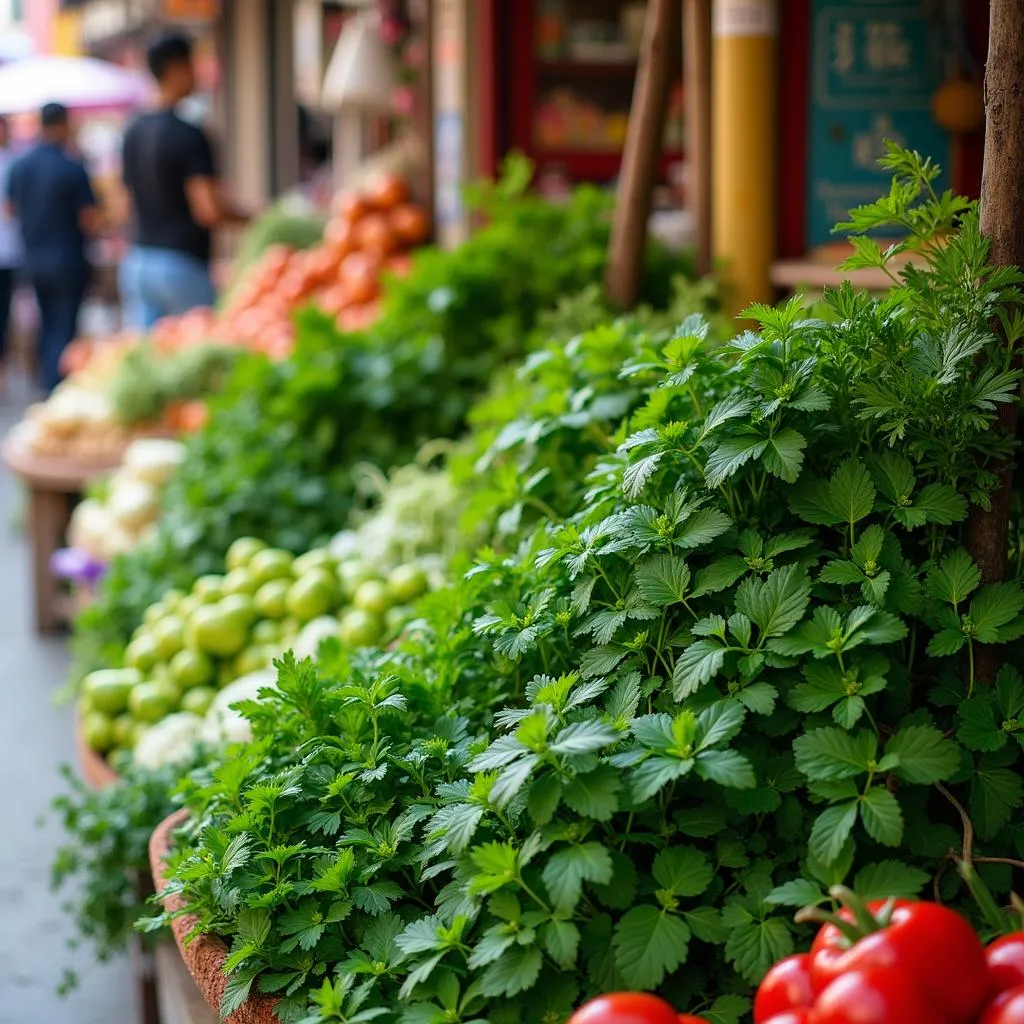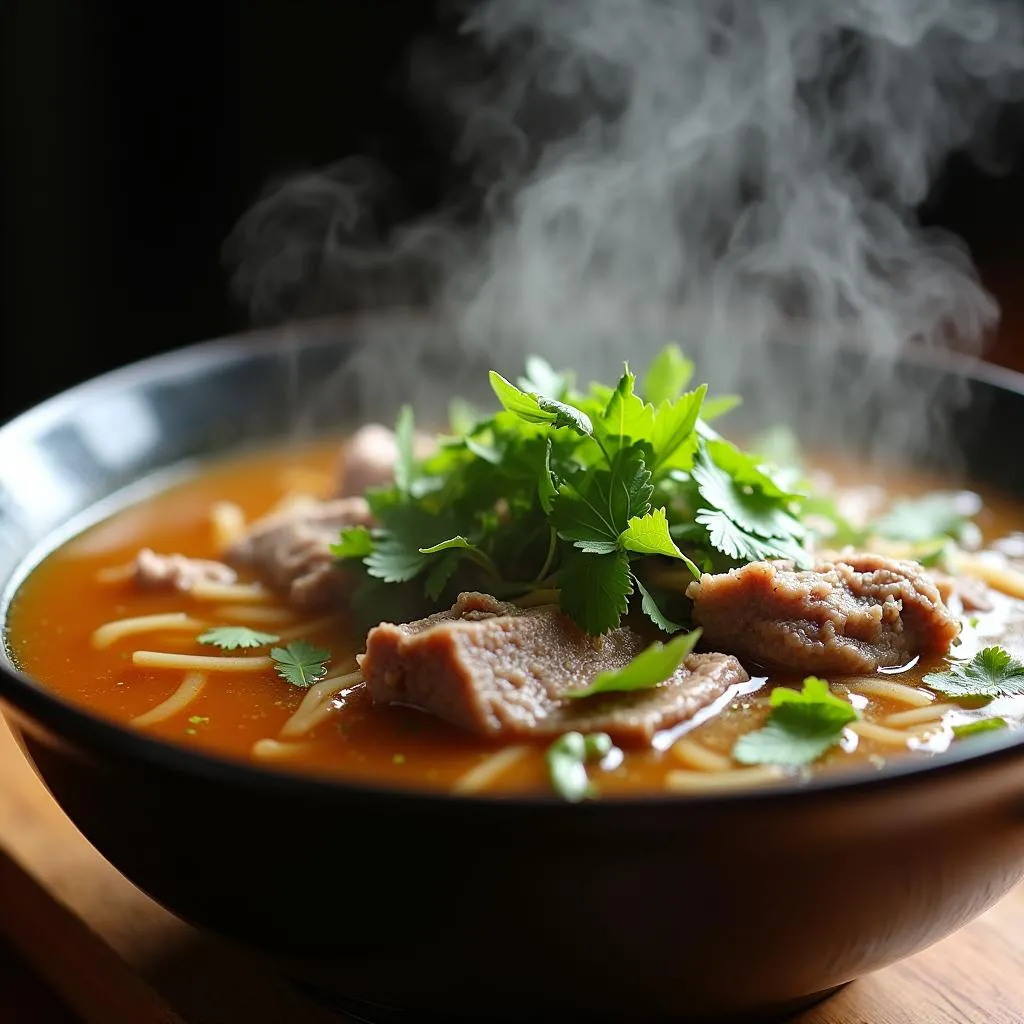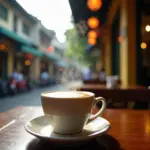Have you ever taken a bite of a Vietnamese dish and wondered, “How did they make this?” The art of preparing Vietnamese food is a sensory delight, a delicate dance of fresh ingredients, aromatic herbs, and vibrant spices. Let’s embark on a culinary adventure and learn how to describe the magic of Vietnamese cooking in English.
From Market to Table: A Sensory Symphony
Imagine strolling through a bustling market in Hanoi’s Old Quarter. The air is thick with the scent of fresh herbs like lemongrass, mint, and cilantro.  Fresh herbs at a market in Hanoi's Old Quarter Vendors expertly chop vegetables with rhythmic precision, while others arrange colorful displays of dragon fruit, mangoes, and rambutan. This vibrant scene sets the stage for the culinary journey that awaits.
Fresh herbs at a market in Hanoi's Old Quarter Vendors expertly chop vegetables with rhythmic precision, while others arrange colorful displays of dragon fruit, mangoes, and rambutan. This vibrant scene sets the stage for the culinary journey that awaits.
The Essence of Vietnamese Flavors: A Balance of Tastes
Vietnamese cuisine is celebrated for its harmonious blend of sweet, sour, salty, bitter, and umami flavors. “Âm dương,” the Vietnamese philosophy of balance, extends to the kitchen, where each element plays a crucial role.
- Sweetness often comes from fruits like pineapple and mango or a touch of sugar.
- Sourness is achieved with lime juice, rice vinegar, or tamarind, adding a tangy kick.
- Saltiness comes from fish sauce (nước mắm), a staple in Vietnamese cooking, providing a savory depth.
- Bitterness is introduced through herbs like bitter melon or certain types of greens, adding complexity to the flavor profile.
- Umami, the savory fifth taste, is often achieved through the use of fermented ingredients like fish sauce or shrimp paste.
The Art of Preparation: Techniques that Tell a Story
Vietnamese cooking techniques are as diverse as the country’s landscape. Each method imparts unique flavors and textures:
- Stir-frying (xào): This quick and flavorful technique involves cooking ingredients over high heat in a wok with a small amount of oil.
- Steaming (hấp): A gentle method that preserves the nutrients and delicate flavors of fish, vegetables, and dumplings.
- Deep-frying (chiên): Used to create crispy textures in dishes like spring rolls (chả giò) or fried tofu.
- Simmering (ninh): A slow and low cooking method that extracts deep flavors from broths and stews.
From Pho to Banh Mi: Describing Iconic Dishes
Let’s put our culinary vocabulary into action and describe some beloved Vietnamese dishes:
Pho: The Soul of Vietnam in a Bowl
“A good bowl of pho should warm your soul,” my friend Lan, a renowned chef in Hanoi, once told me. This aromatic soup features a flavorful broth, rice noodles, tender meat (usually beef or chicken), and an array of fresh herbs. The broth, often simmered for hours with spices like star anise and cloves, is the heart of pho.  A steaming bowl of Vietnamese Pho
A steaming bowl of Vietnamese Pho
Banh Mi: A Symphony of Textures and Tastes
This iconic Vietnamese sandwich is a delightful fusion of French and Vietnamese influences. A crusty baguette is layered with savory fillings like grilled pork, pate, pickled vegetables, cilantro, and a spicy mayonnaise. The combination of textures and tastes creates an explosion of flavor in every bite.
The Language of Vietnamese Food: Key Phrases
Here are some essential phrases to enhance your culinary descriptions:
- “Hương vị đậm đà”: Rich and flavorful
- “Thơm ngon”: Delicious and aromatic
- “Giòn tan”: Crispy and crunchy
- “Cay nồng”: Spicy and pungent
- “Ngọt ngào”: Sweet and delicate
Beyond the Plate: The Cultural Significance of Food
In Vietnamese culture, food is more than just sustenance; it’s a celebration of life, family, and tradition. Meals are a time for connection and sharing, and offering food is a gesture of hospitality and respect.
Need Help Navigating the Culinary Delights of Hanoi?
Contact TRAVELCAR at 0372960696 or [email protected]. Our team can arrange transportation to vibrant local markets, cooking classes, and hidden culinary gems throughout Hanoi and beyond. We offer a range of vehicles, from 16-seater to 45-seater buses, perfect for groups of all sizes. Visit our office at 260 Cầu Giấy, Hà Nội, and let us help you create a delicious adventure you’ll never forget.

